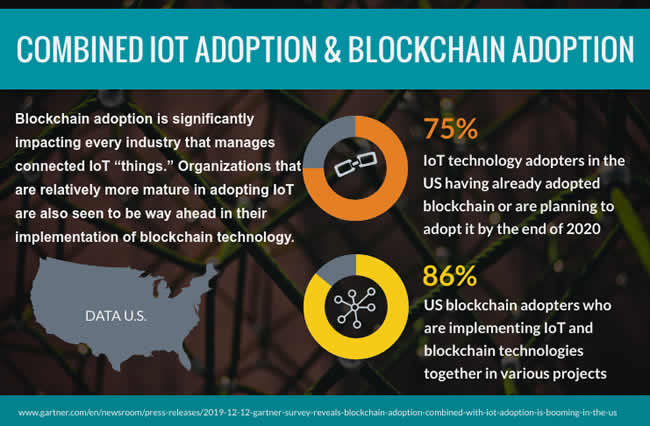“A sweet spot for digital transformation (DX) and innovation.” That’s how Gartner’s Avivah Litan calls the integration of IoT and blockchain networks – with survey data to prove that organizations who have deployed the Internet of Things (IoT) realize it. Findings on combined blockchain adoption and IoT adoption.
Organizations that are relatively more mature in adopting IoT are also seen to be way ahead in their implementation of blockchain technology (Gartner)
It must be said that Gartner has always been very careful with regards to blockchain adoption predictions, warning that ‘real’ enterprise blockchain technology won’t be around for years to come (immature technologies, not enough focus on the use case and so forth) and that many blockchain projects are poised to fail or remain stuck in pilot stages in the meantime while the technologies continue to evolve through several stages and organizations learn from their proofs-of-concept.
Yet, while blockchain technology – in its current state – isn’t that broadly adopted for enterprise applications as some once predicted, Gartner found a fast growth in blockchain adoption by IoT implementers: organizations with IoT implementations indeed.
Moreover, IoT adoption and blockchain adoption often are used together for several projects as the survey data further show.

Even Gartner was surprised by the fact that IoT and blockchain integration is moving ahead much faster than what was previously expected. Note: the survey – and thus results – only included US respondents, more precisely over 500 managers – or above – who were primarily involved and responsible for making decisions with regards to IoT implementation in their respective organizations.
Why and where blockchain adoption and IoT adoption are combined – and ‘booming’
The many – actual and potential – blockchain use cases where IoT and blockchain technologies meet are more or less known, so it’s interesting, though perhaps not that surprising, to see why and where IoT implementers in the US leverage blockchain technology.
One might immediately think about security and trust, where there are quite some initiatives in the IoT and blockchain space, as you might know. And, indeed, for the majority of respondents ‘increased security and trust’ were either cited as the primary or secondary driver to integrate IoT with blockchain networks (nearly two-thirds of respondents to be precise).
However, over half of respondents said that the top benefit is an increase in business efficiency and lowering costs and that is related to the use cases of course which in turn are related to the industries where blockchain and IoT de facto get more combined today.
Three-quarters of IoT technology adopters in the US have adopted blockchain or are planning to do so by the end of 2020
In total, seventy-five percent of respondents who have adopted IoT technology in the US, have either adopted blockchain or plan to do so by the end of 2020.
Among those who have adopted blockchain, eighty-six percent implement both technologies – together – in several projects.
Reminding that blockchain technology is still immature as Gartner tends to – rightfully – often repeat and that blockchain and IoT technologies are still in the early stages of adoption as well, Avivah Litan says that the results are significant, much stronger than anticipated and showing that organizations combine them to drive favorable business outcomes.
Obviously blockchain adoption isn’t equally high in all segments where respondents have implemented IoT. While security is a cross-industry given, trust and security do matter more in some segments than in others. More importantly, there are those blockchain use cases that are more related to the nature of the business/industry.
Especially in pharmaceuticals, the energy sector, natural resources, the utilities industry and transportation, the blockchain adoption rate is highest among IoT implementers, Gartner found.
The reason, in the words of Avivah Litan: “These industries all have business models that include the movement of physical goods, so they benefit from links that bridge the physical to the digital world, especially those enabled by a combination of blockchain and IoT technologies.”
Adoption was lowest in financial services, which is related to the fact that here, indeed, we’re dealing more with virtual goods and services. Not that financial services isn’t important for blockchain of course, it’s the combination with IoT that tends to bridge those digital and physical worlds as in the cyber-physical notion of Industry 4.0, that matters in this scope. Financial services is indeed still a key area for blockchain although it is on the verge of losing its first spot in that regard, which is a different story.
In implementing IoT projects, many organizations focus on efforts to build more transparency, security and trust in around managing and/or moving physical things around in order to improve situational awareness and realize greater efficiencies, Avivah Litan reminds.
She adds that, according to Gartner, through 2024, more than eighty percent of implementers will have to upgrade their combined IoT and blockchain solutions at least once or twice to address technical challenges such as scalability, cybersecurity and reliability. Work and challenges ahead as technologies mature but moving faster than expected seems to be the conclusion with regards to combined IoT adoption and blockchain adoption.
More in the Gartner report “Survey Analysis: IoT Adopters Embrace Blockchain.”

